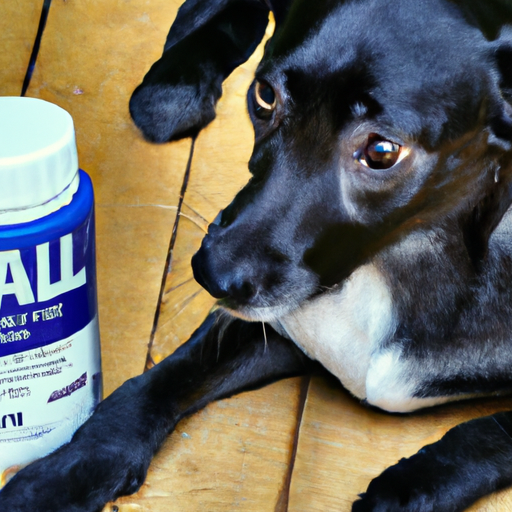How Much Benadryl For Dogs?
Ever found yourself in a bit of a pickle, trying to figure out the right dosage of Benadryl to give your furry friend? You’re not alone. “How Much Benadryl For Dogs” tackles this exact challenge, offering precise, expert-approved guidelines to ensure you’re not underdosing or, worse yet, overdosing your pet. To help alleviate the distress around this subject, this piece offers an easy-to-follow guide to ensure you’re administering the right amount of Benadryl for your dog’s weight, condition, or reaction to allergens. Now, you can confidently soothe your pet’s allergies, anxiety, or travel sickness with the right dosage, and secure in the knowledge that you’re doing it right.

Understanding Benadryl and Its Uses
Benadryl, the brand name for the drug diphenhydramine, is an over-the-counter medication commonly used by humans to relieve symptoms of allergies, hay fever, and the common cold. However, it’s not just people who can be affected by these conditions. Dogs, too, can suffer from allergies and other ailments relieved by this antihistamine.
What is Benadryl?
Benadryl is a first-generation antihistamine. It works by blocking the H-1 receptors on the smooth muscle and blood vessels in your pet’s body. This helps to reduce the effects of histamine, a substance released during allergic reactions that causes itching, sneezing, runny nose, and watery eyes.
Common Uses of Benadryl in Dogs
You might not realize it, but your pup can experience a host of uncomfortable symptoms that might be resolved with the help of Benadryl. For a dog suffering from seasonal allergies, insect bites, or even motion sickness, Benadryl can significantly improve their quality of life. The medication also has a mild sedative effect, making it useful in helping dogs that suffer from insomnia, or who are very agitated in particular situations like thunderstorms or fireworks.
Determining the Correct Dosage of Benadryl for Dogs
Like any medication, it’s important to use Benadryl correctly to ensure it’s both safe and effective for your dog.
Factors Influencing Dosage
Numerous factors can impact the ideal dosage. Your dog’s weight, age, overall health condition, and the severity of their symptoms all play a role.
General Rule for Benadryl Dosage in Dogs
However, as a general rule of thumb, veterinarians suggest an oral dosage of 1 milligram of Benadryl per pound of body weight, given 2-3 times a day. However, this can vary based on the factors mentioned before, so it’s always best to consult with a vet before beginning treatment.
Administering Benadryl to Dogs
Fortunately, Benadryl is relatively easy to administer to dogs.
How to Give a Dog Benadryl
Most dogs will accept Benadryl as is, but, in case your dog proves fussy, you can always hide the pill in a treat, a small piece of food, or use a pill pocket.
Monitoring Your Dog After Administration
After giving your dog Benadryl, it’s important to monitor them for any adverse reactions, especially the first time they take it. Observation will help ensure that the dosage is correct and that your dog isn’t experiencing any negative side effects.
Possible Side Effects of Benadryl in Dogs
As useful as Benadryl can be, it’s important to be aware of the possible side effects that your dog might experience.
Common Side Effects
Most side effects of Benadryl are mild. These can include dry mouth, drowsiness, and urinary retention. While these are generally not concerning, they can still cause discomfort for your dog.
Serious Side Effects and When to Seek Veterinary Assistance
In some cases, dogs can have more serious reactions to Benadryl. Rapid breathing, an increased heart rate, or signs of an allergic reaction, such as hives, swelling, or difficulty breathing should not be ignored and require immediate veterinary attention.
Alternative Forms of Benadryl
If your dog isn’t partial to pills, don’t worry. Benadryl comes in other forms that can be easier to administer.
Capsule Form
The capsule form of Benadryl is easy to dose and can be hidden in your dog’s food or a treat.
Liquid Form
Liquid Benadryl can be useful for smaller dogs, as it’s easier to measure out the proper dose. Make sure to use the children’s Benadryl formula, as the adult one contains alcohol, which is not safe for dogs.
Topical Solutions
For localized itching or inflammation, a topical cream or spray can provide relief right where your dog needs it most.
Benadryl for Specific Dog Breeds
Breed does not heavily influence the effectiveness of Benadryl, but there are some general guidelines to follow.
Small Breed Dogs and Benadryl
Smaller breeds might be at more of a risk of overdose due to their size. Therefore, it’s especially important to carefully dose Benadryl according to their weight.
Large Breed Dogs and Benadryl
Larger breeds require a higher dose of Benadryl due to their size. However, other factors such as age and health should still be considered when determining the right dose.
Interactions with Other Medications
As with any medication, there are certain drugs that may interact with Benadryl.
Drugs Commonly Known to Interact with Benadryl
If your dog is currently taking medications such as sedatives, tranquilizers, or any type of heart medication, you should consult your vet before giving Benadryl.
Considerations When Dog is on Other Medications
It’s important to notify your vet of any drugs your dog is currently taking, including non-prescription medications, as these can interact with Benadryl as well.
When to Avoid Giving Benadryl to Dogs
Benadryl is generally safe for most dogs, but it’s not suitable for every pet.
Canine Health Conditions That May Contraindicate Use
If your dog suffers from health conditions like high blood pressure, cardiovascular disease or glaucoma, use of Benadryl may not be advisable.
Situations Where Benadryl May Not Be Advisable
If your dog is pregnant or nursing, consult your vet before administering Benadryl.
Frequency of Benadryl Administration
Benadryl can usually be given 2-3 times a day, but this depends on the dog’s condition.
How often can you give a dog Benadryl?
The specific frequency and dosage depend on your dog’s needs and the severity of their symptoms.
Long-Term use of Benadryl in Dogs
In some cases, long-term use might be required. However, it’s always best to consult with your vet to see if long-term use is safe for your pet.
Consultation with a Veterinarian
It’s important to remember that you should always consult with your vet before starting any new medication regimen with your dog.
The Importance of Consulting a Vet Before Administration
Even over-the-counter medications can have serious side effects if used improperly. A vet will be able to determine if Benadryl is the right choice for your pet and what the proper dosage should be.
What Questions to Ask Your Vet
Be sure to ask any questions you may have during your appointment. These can range from dosing questions to potential side effects and interactions with other medications. Your vet is there to help and ensure that your dog is as healthy and comfortable as possible.






